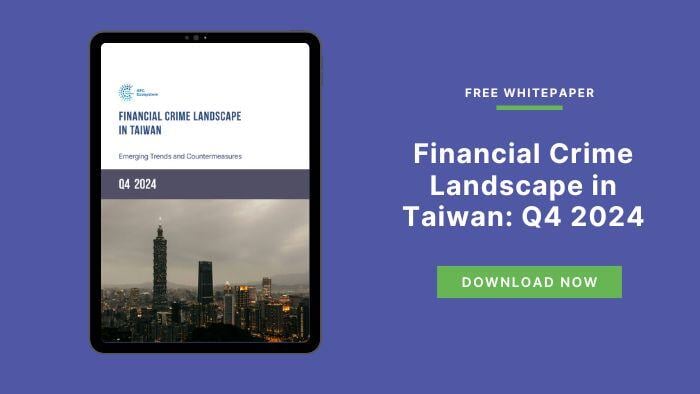What Taiwan’s 2024 Amendments to the Money Laundering Control Act Mean for Financial Institutions
Introduction
As financial crime continues to evolve, so too must the frameworks designed to combat it. For Taiwan, anti-money laundering (AML) compliance has long been a critical focus—especially under the scrutiny of international bodies like the Financial Action Task Force (FATF).
On July 31, 2024, Taiwan made a decisive move by amending its Money Laundering Control Act (MLCA) to close loopholes, strengthen enforcement, and align more closely with global AML standards. These changes are not merely administrative—they have direct and far-reaching implications for how financial institutions, fintechs, and regulated entities operate in Taiwan.
This blog breaks down the key changes to Taiwan’s MLCA, what they mean for compliance professionals, and how institutions can future-proof their AML strategies in light of the revised law.
Background: Taiwan’s AML Landscape Before the Amendments
Taiwan has made significant progress in recent years to address AML/CFT challenges and shed concerns raised during FATF mutual evaluations. Once placed under increased monitoring (the FATF “grey list”), Taiwan has since strengthened supervision over high-risk sectors, such as virtual asset service providers (VASPs), casinos, and corporate service providers.
However, gaps remained, particularly in:
-
The regulation of Designated Non-Financial Businesses and Professions (DNFBPs)
-
Cross-border fund flow surveillance
-
Integration of digital ID systems into onboarding and due diligence
-
Technology adoption for real-time risk detection
The 2024 amendments to the MLCA are Taiwan’s response to these challenges—enhancing enforcement mechanisms while modernising the law to reflect digital-era threats.
Summary of the July 31, 2024 Amendments
The 2024 amendments introduce a sharper and more comprehensive version of the MLCA, focusing on enforcement, sectoral accountability, and broader risk coverage.
Key changes include:
1. Expansion of Reporting Entities
The definition of entities obligated to file suspicious transaction reports (STRs) has been broadened. This now includes:
-
Crypto exchanges and wallet providers
-
Foreign-exchange businesses
-
DNFBPs including law firms, accountants, and real estate brokers
2. Stronger Penalties for Non-Compliance
Fines for institutions failing to comply with STR or KYC requirements have increased significantly. Repeat violations can lead to licence suspension or revocation.
3. Mandatory Risk-Based Due Diligence
All regulated entities are now required to adopt risk-based due diligence practices, especially for high-risk customers and cross-border transactions.
4. Beneficial Ownership Transparency
Stricter rules have been introduced to disclose and validate the beneficial ownership of corporate accounts and legal entities.
5. Enhanced Powers for Regulators
Supervisory authorities now have expanded investigation powers and can conduct real-time audits. There is also provision for increased data sharing between agencies to identify patterns of illicit behaviour.
Key Implications for Financial Institutions
The amended MLCA creates both compliance opportunities and operational urgency for financial institutions in Taiwan. Institutions that are proactive in aligning with the changes will benefit from smoother regulatory interactions and stronger defences against financial crime.
🔍 Tighter KYC and Onboarding Standards
Financial institutions must now validate customer identity more rigorously, especially in sectors with known money laundering vulnerabilities, such as remittance services, real estate, and cryptocurrency exchanges.
🌐 Greater Oversight on Cross-Border Transactions
AML systems must be able to detect geographic mismatches, small structured transactions (smurfing), and fund flows linked to high-risk jurisdictions—both in real time and during audits.
🛠️ Technology and Resource Pressures
Smaller institutions may struggle to meet new demands using traditional systems. Manual reviews are not scalable under the updated requirements, particularly when handling large transaction volumes.
📄 Audit-Ready Documentation
With regulators gaining more real-time oversight capabilities, institutions must ensure transaction monitoring systems and case managers are fully audit-ready—with clear documentation, alert disposition history, and policy enforcement logs.
Recommendations for Compliance Teams
Now is the time for institutions to assess, upgrade, and future-proof their compliance operations. Here’s how:
1. Review and Update Internal Policies
Align internal AML frameworks with the new MLCA requirements. This includes STR procedures, KYC checklists, and escalation workflows.
2. Conduct Staff Training
Frontline staff and analysts must understand the updated obligations—especially around new customer segments and transaction types under the law.
3. Reassess Risk Scoring Models
Update your risk models to factor in newly regulated sectors, transaction types, and behaviour-based indicators tied to emerging threats (e.g. mule accounts, digital ID abuse).
4. Invest in Scalable, AI-Driven Compliance
Traditional rule-based systems cannot adapt fast enough to regulatory change. Institutions should explore AI-powered solutions that support:
-
Real-time scenario simulation
-
Dynamic thresholding
-
Low false-positive detection
-
End-to-end case management
How Tookitaki Supports Institutions in Taiwan
Tookitaki’s FinCense platform is purpose-built to help financial institutions adapt quickly and confidently to AML reforms like Taiwan’s 2024 MLCA amendments.
Key benefits include:
-
AI-powered transaction monitoring with up to 90% false positive reduction
-
Pre-built AML scenarios aligned with FATF and local regulations
-
Seamless integration with digital onboarding and KYC systems
-
A smart case manager that auto-documents investigations and generates audit-ready reports
Powered by the AFC Ecosystem
Through Tookitaki’s Anti-Financial Crime (AFC) Ecosystem, institutions in Taiwan can access a growing library of real-world AML typologies contributed by global experts—helping them stay ahead of new risks and compliance expectations.
Conclusion
Taiwan’s 2024 amendments to the Money Laundering Control Act represent a significant step forward in the country’s commitment to fighting financial crime. For financial institutions, this is both a regulatory shift and a strategic opportunity.
Institutions that invest in modern, intelligent compliance solutions today will be better positioned to navigate evolving expectations tomorrow—building trust, avoiding penalties, and protecting the financial system.
Anti-Financial Crime Compliance with Tookitaki?






